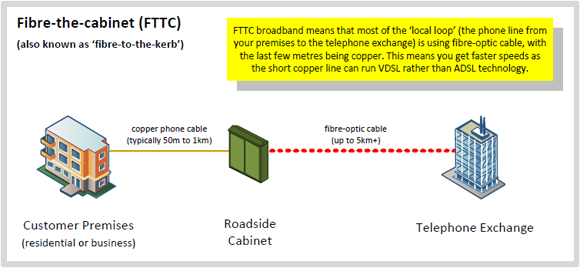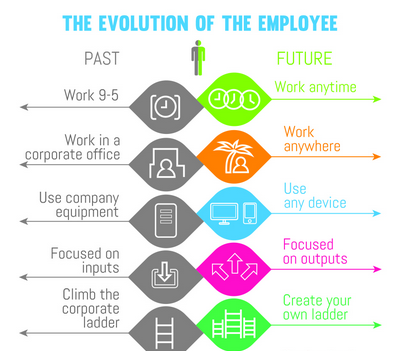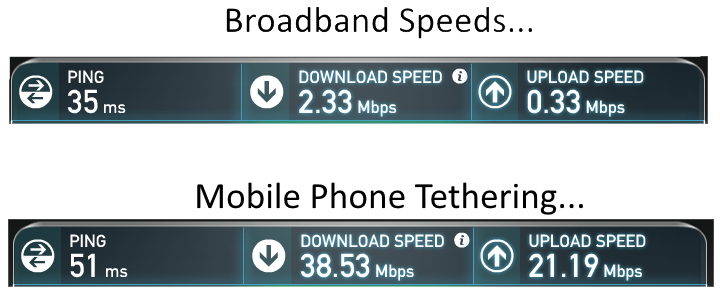Seriously, have we reached full capacity? I’m speaking specifically about traditional broadband connections, not fibre broadband. The ‘old’ broadband running on the copper lines from the exchange. It seems that this technology is well and truly full, at least based on personal experience and that of anecdotal evidence from speaking with other people in a similar situation.
To put this into context, previously the internet connection at home has been more than adequate for a good number of years based on the type of activities within the household. More recently, since our old provider was bought out by a larger provider and my personal working habits have changed slightly, I am starting to question if the current broadband infrastructure has reached full capacity and I’m putting the question out there, have you noticed any difference recently in your home non-superfast internet speeds?
Superfast Internet
The rollout of superfast broadband throughout the UK is absolutely needed, but have we gone far enough with the rollout? The current superfast broadband rollout is what is technically known as Fibre to the Cabinet, FTTC for short. In lay-person speak, this means that there is now a fibre connection from your local telephone exchange to the little green box at the end of your street.
Traditionally, this part of the journey was powered using copper wire. This is a problem due to the laws of physics. Transferring data (i.e. your internet connection) is significantly faster through a fibre optic cable than through the old copper wires. Hence why the rollout of fibre broadband was essential as data usage has significantly increased over recent years with the growth of services such as Netflix, YouTube, Amazon Prime, Tesco Blink, Xbox Live, Online Gaming and more.
But I question whether we have gone far enough with the upgrades and whether we actually have a long term solution in place for the growing data requirements for home and business users. The current superfast broadband rollout is a significant improvement which has implemented the improvements to part of the line as can be seen below;

Source: http://www.thinkbroadband.com/guide/fibre-broadband.html
What you will notice is that this isn’t the whole picture. There is part of the connection which is still using the older technology, which is the part of the connection between your green box and your home. For office use, this generally is not a problem as there is either a leased line to the premises or similar technology making the internet connection truly superfast. For some users, and most importantly, the growing remote and flexible workers as part of your workforce, this is actually a large problem. Personally, there is rarely a working day that is the same, with work being completed in various locations depending on the plan for the week. Which means that for myself personally, I could be experiencing internet connections with down streams nearing 100 mb/s or as poor as 2mb/s with continuous dropouts depending on the time of the day. While this doesn’t interrupt any activities, it does require a little more planning, a backup plan in place at all times in the form of mobile data, oh, and the forced upgrade to a fibre connection – more on that later though.
Speaking based only on anecdotal evidence, on a traditional broadband connection at home, the evidence is clear, broadband connectivity issues starting around 3:30pm, peaking around 5pm, starting to tailor off around 7pm. What I’m talking about here is when the internet connectivity gets so bad that it is not possible to load a website or connect to the internet. After a lot of thought on the topic, the only conclusion that I can make based on this is that children are arriving home from school at around 3:30pm, accessing all of the on-demand services, clogging up the internet then going to bed around 7pm. Thinking through many options that could be causing this, along with endless discussions with home broadband technical departments working to ‘resolve the issue’ (and failing miserably), it is clear that the old provider was not able to fix the issue which I believe to be related to the capacity crunch that we are all experiencing invisibly at the minute.
The Capacity Crunch
The next step of my personal story is that we are moving to superfast fibre broadband at home, not out of a want for faster speeds as for home use, traditional broadband used to be absolutely fine for our needs as a home user. No, we are moving to a superfast fibre connection out of necessity. As part of the process, one comment from the new supplier struck a cord and made me think about what has actually happened with the recent broadband rollout project within the UK. The comment was that the new provider is going to have to send out an engineer to the green box and flick us on to fibre.
So in summary, unless you are paying directly for a fibre connection, you simply aren’t benefiting from this new technology. Call me a cynic, but this does seem a little strange why home users aren’t automatically switched over to this upgrade when they already often paying reasonably hefty prices for basic usage, on the whole – and that the project was part funded (50/50) by the European Union through the European Regional Development Fund and local authorities throughout the UK.
The question I came to ask myself was whether we, as home consumers, were being forced down a paid upgrade route when the reality is that the current service being provided simply isn’t up to scratch and is not fit for purpose. The copper pipe is already full which is causing service issues for those people using traditional broadband technology.
Another topic in this area, which we will cover in more depth in another blog post is the difference between broadcast technology (i.e. your live TV) VS streaming technology (i.e. anything over the internet). We’ll look at the technical details a little more another time, for now, the key point is that broadband technology is a first-come-first-serve basis, meaning that if there is a certain amount of capacity on the old copper lines, then whoever uses the capacity first wins and those who aren’t quick enough lose out. All of this is clearly a little more complex than this in the background and simply put, those closer to the exchange have priority over the bandwidth. Meaning that the further away from your local exchange you are, the further down the pecking order you are when it comes to getting your fair share of bandwidth and often those further out are left with the crumbs at the end.
It may be no surprise to you based on the tone of this blog post that we aren’t quite sat next to the local exchange at home. Never the less, we also aren’t tens of miles away either. Traditional broadband has been (up until recently) and should be absolutely fine for our needs, yet it isn’t. Instead, a forced ‘upgrade’ to a fibre service is required to maintain basic connectivity to the home, not to get 200x the speed we currently get.
The Cloud
Putting this into context from a business perspective as a whole, more and more staff are requesting home and flexible working options for various reasons. The image I came across on LinkedIn recently resonated with a lot of people and really does go to show where business and the idea of ‘work’ is heading;

Attribution required: If this is your image, get in touch and we’ll credit you accordingly J
The concept of a modern day working environment requires an unbelievable robust internet connection throughout the UK that can be enjoyed by all. One that I do not believe we have. The recent upgrades are a step in the right direction but we need more.
As more businesses migrate their entire business to the cloud for all of the benefits this brings, the key to all of this working seamlessly is a robust internet network. With accounting software, project management software, research tools, file storage systems, customer relationship management systems and more all being contained within the cloud. This all only works with a fantastic internet connection throughout all parts of the data journey.
The Reality for Many
While this blog post may seem like a little rant against poor performing internet speeds at home, it isn’t. I’ve had that spat directly with the current provider on Twitter J No, this blog post is to highlight the issue that many people are currently experiencing yet there seems to be no real long term solution to this growing problem. Sure, we have had a significant improvement in the form of fibre broadband throughout the UK, but this is not going to last and quite frankly this rollout is not the inclusive Britain that we all aim to strive for. The ever increasing costs related to basic services, and I do include internet in this category, needs addressing and a real solution needs to be identified.
Browse through the swarms of people on Twitter complaining every day about broadband connection speed problems from all suppliers à https://twitter.com/search?f=realtime&q=slow%20broadband&src=typd. Backing up personal anecdotal evidence. This isn’t just the reality for a small number of people, this is a problem impacting an awful lot more people than those just voicing their opinions on Twitter.
Again, putting this into perspective, when comparing home broadband speeds directly with data speeds when connecting to the internet via a mobile phone provider, it is clear there is an issue with the technology;

The mobile data tariffs are just way too expensive currently to warrant permanent connectivity through mobile phone networks. Although maybe this is a longer term solution and the reason why BT is looking to buy EE for £12.5 billion, the largest and fastest mobile network throughout the UK.
The Future
So where do we go from here? Clearly this is a problem where the solution is a little more involved than my thoughts in a blog post. With some interesting blog posts coming from BT on the matter recently, the issue is clearly already under discussion;
“BT’s head of optical access, Professor Andrew Lord, who will take part in the conference said: “It’s the first time we have had to worry about optical fibres actually filling up. We could expand the network by laying more cables but the economics of that do not work and it would increase power consumption. Prof Lord added that a possible solution to the problem would be to ration internet access, where household consumers and businesses would be charged for the amount of data they use.” – Source (5th May 2015)
“The internet will not need to be rationed in the future because of a “data capacity crunch”, according to a leading scientist from telecoms giant BT.” – Source (11th May 2015)
Whatever the solution, it is clear that more needs to be done by all the key players in this market to address these issues, and fast. Many web services are seeing exponential growth in data usage as consumer behaviour shifts from broadcast to on-demand services which is only going to grow further. Couple this with the future horizon in an internet connected world with the Internet of Things, we have a serious crunch approaching in my opinion.
This is purely my personal opinion on where we are at currently and where we are heading. It would be great to hear your thoughts on the topic and share your experience in the comments. Do you think the internet has reached full capacity? Do you think we are heading for a capacity crunch? Or are you simply loving your new fibre broadband speeds streaming series after series of the latest dramas on Netflix?
Michael Cropper
Latest posts by Michael Cropper (see all)
- WGET for Windows - April 10, 2025
- How to Setup Your Local Development Environment for Java Using Apache NetBeans and Apache Tomcat - December 1, 2023
- MySQL Recursive Queries – MySQL While Loops – Fill Zero Sum Dates Between Dates - October 6, 2023

Michael, thank you for an interesting but also quite concerning article. Looks like the solution might be in the mobile network replacing the optical fibres in the future. However, it’s hard to determine how expensive would the Internet become for the average consumer in consequence of the switch.
I am wondering if there’s any data available on how many UK businesses decide to move their entire infrastructure to the cloud each year.This would certainly help in determining what impact this could have on the internet speeds in the years to come.
Again, based on anecdotal evidence, knowing a lot of companies and their IT setup, more and more businesses are moving to the cloud. As the services such as Dropbox and OneDrive are making this transition extremely easy for the novice user. I’m sure there will be some global/UK statistics somewhere around that someone has done on the topic. As part of an 18 month programme that we were involved with training local SMEs to utilise cloud technology, during this time we helped over 500 businesses in this exact area.
Also, I spoke with a friend about the above topics who is more into the traditional IT hardware side of things (which isn’t particularly my area of expertise) and he had some interesting clarifications to make on the matter – ultimately many of the problems are being caused due to lack of investment from service providers. Summarised transcript below;
—
Good article, the questions you have. But the information and answers you have arrived at are wrong! The copper network being at capacity is wrong, mainly. Your copper line is unique to you from your house to the exchange and you’re not fighting anyone for a copper signal (DSL). It’s not shared at any stage. Your copper line carries your phone and broadband signal only, no one elses. The issue you’re actually dealing with is ISP congestion. Possibly with the back haul at the exchange (not copper analogue anymore, but digital links which may be copper, but may also be optical), but it may be with the ISP’s core network. In either case it is capacity beyond the copper network that is the problem. Fibre does not escape capacity issues other than that you will be migrated to a different backhaul because you have placed a new order for a new service. You could have fought it out with your previous ISP and if they were any good, would have logged a performance result and had you moved to an uncontended backhaul link (or virtual path) whilst remaining on ADSL. You get what you pay for however and not all ISP’s know how to resolve this issue quickly.
…
The equipment is almost irrelevant. It’s who owns it and how it’s used and maintained. All standard exchanges started out life as BT wholesale. BT wholesale backhaul links. They were originally dubbed 20cn (20th century) and were connected to the first set of dslams (counterpart to your modem) which your modem sees and syncs with at upto 512k, then 1mbps, then 8mbps ADSL. Then BT rolled out 16mbps using new Dslams and provided better capacity with what was dubbed the 21cn (21st Century network). This provided greater capacity backhaul links and it is possible that if you’re not on an LLU circuit, your fibre will still use the same 21cn backhaul link out of the exchange that 16 meg services use. If ever you are with an LLU ISP, like sky or talk talk, it’s down to that ISP to manage their own backhaul (a similar 21cn style link out the exchange). Simply put, no matter the technology the customer is on, it’s about proper management of the backhaul links out the exchange. Every exchange will have several ‘pipes’ out. Whether it is 20cn BT, 21cn BT, or LLU, and multiple of each. It’s the wholesale ISP’s responsibility to evenly balance customers across their capacity. Notice I say wholesale.. ISP’s without LLU rely on the wholesaler to manage it correctly so it’s not always an ISP’s fault. Sky however are LLU so it’s down to them to investigate and resolve.
…
Exactly. Local Loop Unbundling. It allowed an ISP access in the exchange to situate their own equipment and then plumb in a backhaul of their own to supply ‘the internet’. It made it cheaper firstly, as ISP’s were no longer held to ransom by a single greedy wholesaler. It also sped up the speed race as competition heated up. The main thing is that if ever you have an issue, any decent ISP should assess all your symptoms, go through the applicable diagnostics with you and within a couple of calls be able to get things moving in the right direction, whether that it’s a fix needed on your end or a fix within the exchange!
…
Sky probably just had a ‘hot’ VP (over utilised virtual path). One of the many virtually configured data paths within a backhaul link. If they moved you to any other VP it would likely have been fixed! Would take them about 24 hours to fix from them admitting to you it was ‘hot’, after doing their required diagnostics (throughput speed not matching sync speed closely enough during peak periods). Still, you got the same result moving ISP. You will generally be provisioned on a VP that is not ‘hot’, but time may eventually mean you have more customers on the same VP eventually. If it happens again- have your ISP guide you!
—